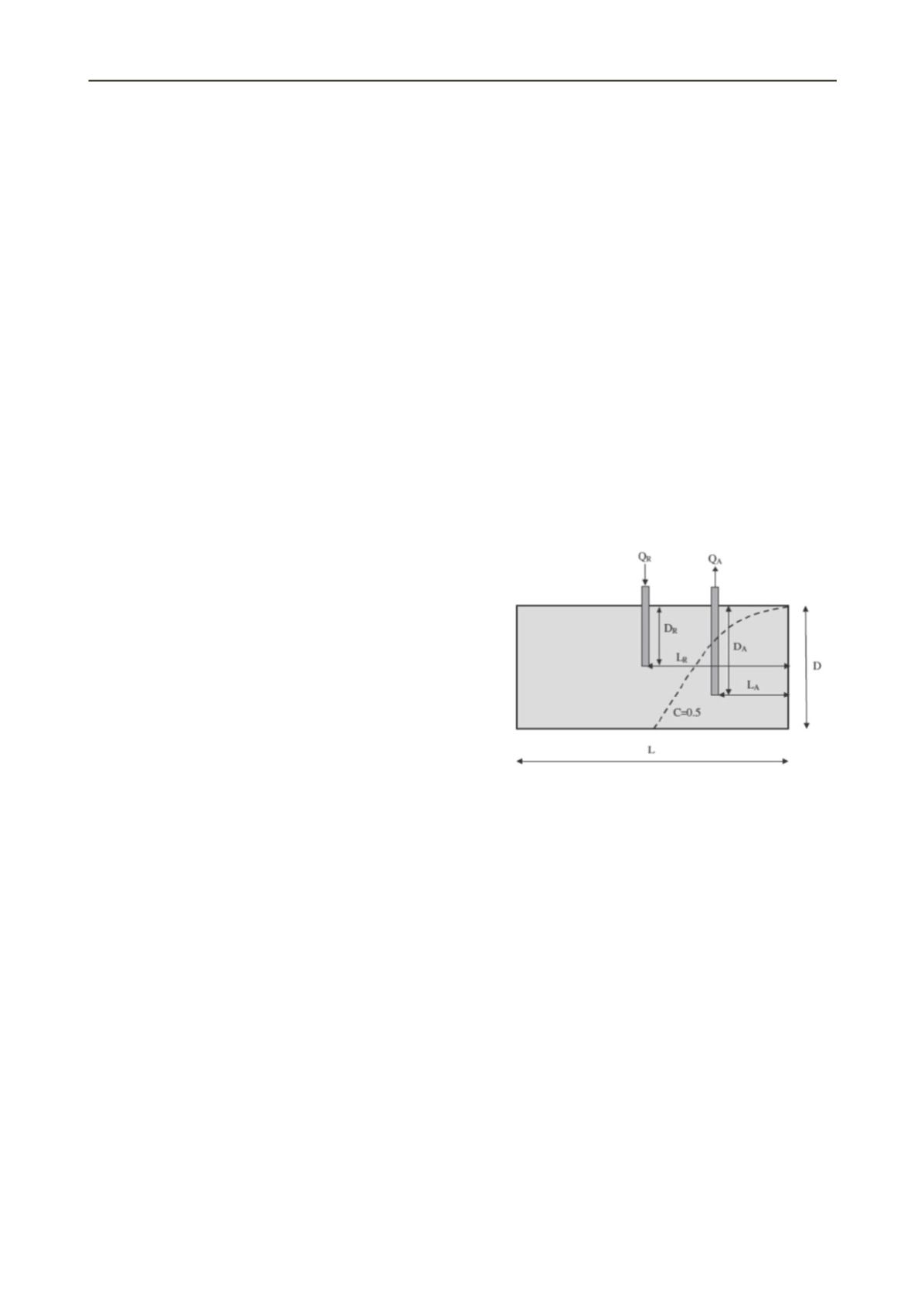
741
Technical Committee 103 /
Comité technique 103
4 FORMULATION OF MANAGEMENT MODELS
The developed simulation-optimization model was applied to
the hypothetical aquifer in order to seek the optimal cost-
effective strategy to control seawater intrusion. The aquifer was
subjected to three management scenarios: abstraction of
brackish water, recharge of fresh water,
and combination of
abstraction, recharge and desalination (ADR).
The main
objectives of these scenarios were to minimize the total
construction and operation costs of management process and
also to minimize the total concentration of salt in the aquifer.
These multiple objective functions are represented
mathematically using a single scalar objective function
(Qahman et al., 2009 and Park and Aral, 2004) for each scenario
as follows:
Management model 1 (Abstraction only)
.
.
.
.
.
.
(1)
Management model 2 (Recharge only)
.
.
.
.
.
.
(2)
Management model 3
(Abstraction, Desalination and
Recharge ADR)
.
.
.
.
.
.
.
.
.
.
(3)
where
f is the objective function in terms of the total cost.
N is the total number of nodes in the domain.
c is the total amount of solute mass in the aquifer (mg/l).
P
1
, P
2
, P
3
,P
4
and P
5
are the weighting parameters.
D
A
is the depth of abstraction well (m).
Q
A
is the abstraction rate (m
3
/s).
C
A
is the cost of abstraction ($/m
3
).
C
T
is the cost of treatment ($/m
3
).
C
DW
is the cost of installation/drilling of well ($/m).
Q
R
is the recharge rate (m
3
/s).
D
R
is the depth of recharge well (m).
C
R
is the cost of recharge ($/m
3
).
C
PW
is the price of water ($/m
3
).
In the first scenario the effect of continuous abstraction of
brackish water from the well was considered. This model has
three decision variables: location, depth and rate of abstraction.
In the second scenario the aquifer was subject to artificial
recharge of freshwater into a well as the strategy to increase the
hydraulic gradient of groundwater toward the sea. Location,
depth, and recharge rate are considered as the decision variables
to be optimized to reduce the total cost. The third management
scenario was developed by combining management models 1
and 2 to prevent/control seawater intrusion. Locations, depths,
and abstraction/recharge rates of the abstraction and recharge
wells are considered as decision variables. Figure (3) shows the
decision variables considered in the simulation-optimization
model.
Based on the available decision variables in each
scenario, the management objectives are achieved within a set
of constraints including side constraints for well depths, well
locations and abstraction/recharge rates as:
0.0 < Q
A,R
(m
3
/sec) < 0.1
,
0.0 < L
A,R
(m) < 200.0
and
0.0 < D
A,R
(m) < 100.0
.
In these management models the costs are considered based
on the available data from literature. According to the literature
these costs are considered as (Qahman and Larabi, 2006):
-cost of installation/drilling of well per unit depth: US$1000,
- cost of abstraction per cubic meter: US$0.42,
- cost of recharge per cubic meter: US$0.48,
- cost of treatment (desalination) per cubic meter: US$0.6
- price of water per cubic meter: US$1.5..
The GA parameters used are: population size = 100,
probability of crossover = 0.7, and probability of mutation =
0.03. Typical CPU time used for 100 generations is about 3 h on
an Intel Core i7 8 at 2.8GHz with 8GB RAM.
Figure 3. Schematic sketch for potential locations and depths for the
abstraction and recharge wells
5 RESULTS AND DISCUSSION
The results obtained from the simulation-optimization process
for all management scenarios in terms of the optimal depth,
location and rate of the abstraction/recharge well with the
corresponding total costs are summarized in Table (2). The total
cost required to control seawater intrusion using the first
management model is determined as $2.62 million per year. The
optimal depth is 90m, the optimal location is 50m from the
seashore, and the optimal abstraction rate is 0.083m
3
/s, while
the total concentration in the aquifer is reduced from 167 to 149
mg/l. In the second management scenario, the total cost is $5.72
million per year, the optimal depth is 60 m, the optimal location
is 90m from the seashore, and the optimal abstraction rate is
0.095m
3
/s, while the total concentration has reduced from 167
to 151 mg/l. Using management model 3, the total cost is $1.32
million per year. The optimal depths for abstraction and
recharge wells are 90m and 80m, respectively; the optimal
locations for abstraction and recharge wells are 50m and 110m
from the seashore, and the optimal rates for abstraction and
recharge wells are 0.018m
3
/s and 0.048m
3
/s, respectively. The
total concentration in the aquifer is reduced from 167mg/l to
142mg/l.
Although, all three management models reversed seawater
intrusion into the coastal aquifer and moved the transition zone
between the seawater and freshwater toward the sea, the third


